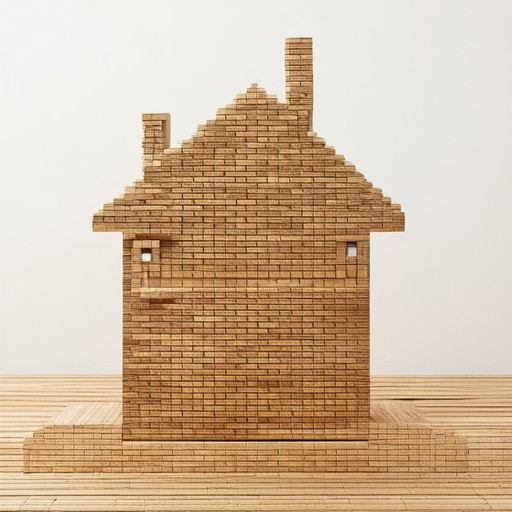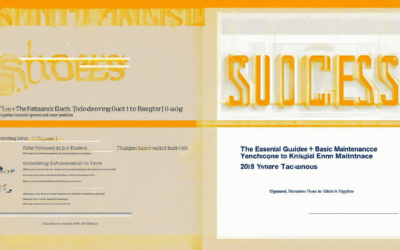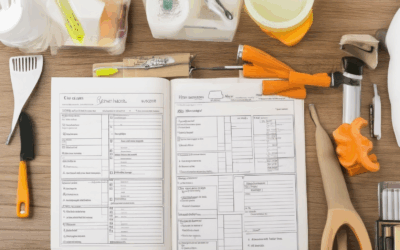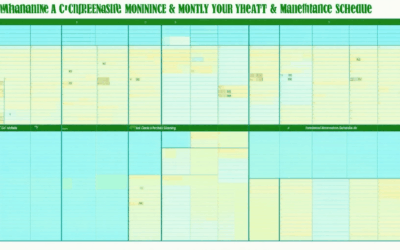Homeownership comes with its fair share of responsibilities, but mastering the art of home maintenance can seem overwhelming at first. Whether you’re a seasoned homeowner or new to the game, understanding the right strategies is key to preserving your investment and ensuring your space remains comfortable and functional for years to come. One approach that has gained traction is the “1% Rule,” a simple yet powerful method that emphasizes incremental improvements to prevent major issues down the line. By dedicating just 1% of your time or budget to home maintenance each week, you can address minor concerns before they escalate, ultimately extending your home’s lifespan and saving yourself from costly repairs. But there’s more to it than just the 1% Rule—effective home maintenance also involves creating a personalized checklist, leveraging house hacks, and adopting a proactive mindset. In this guide, we’ll explore these strategies, providing actionable tips and insights to help you maintain your home in peak condition. From annual tasks to daily routines, discover how to stay ahead of potential issues and keep your property in excellent shape. Whether you’re looking to save money, prolong your home’s life, or simply enjoy a more comfortable living environment, this article is your ultimate resource for unlocking home maintenance success.
Key Takeaways
- Prioritize the 1% Rule: Focus on maintaining HVAC, plumbing, electrical, and roofing systems to prevent costly breakdowns and ensure long-term functionality.
- Schedule Annual Inspections: Regularly check exteriors, interiors, HVAC systems, plumbing, electrical systems, and landscaping to catch issues early.
- Proactively Maintain Appliances: Clean and service appliances, check smoke detectors, and ensure proper venting to enhance safety and efficiency.
- Use a Comprehensive Checklist: Include tasks like cleaning, checking windows, gutters, flooring, and foundational elements to maintain home integrity.
- Stay Updated on Best Practices: Keep informed about local codes and maintenance guidelines to ensure your home meets current standards.
- Invest in Professional Help: When needed, hire experts for thorough inspections and repairs to address hidden issues.
- Enhance Energy Efficiency: Regularly service HVAC systems and seal homes to reduce energy waste and lower utility costs.
- Protect Against Pests and Weather: Inspect for pests, trim trees, and maintain gutters to safeguard your home against damage.
- Maintain Safety Features: Test alarms, check electrical systems, and ensure proper chimney function to prevent accidents.
- Extend Home Lifespan: Through consistent care of structural elements and systems, preserve your home’s value and durability.

What is the 1% Rule for Home Maintenance?
The 1% rule for home maintenance is a simple yet effective strategy to ensure your property stays in great shape. Here’s how it works:
1. **Calculate Your Annual Maintenance Budget**: Start by determining 1% of your home’s purchase price. This percentage should be set aside annually for routine maintenance tasks.
2. **Examples of Home Maintenance Needs**: – **HVAC Systems**: Regular check-ups, filter changes, and tune-ups. – **Plumbing**: Leaky pipes, water heater inspections, and replacements. – **Roofing**: Annual inspections and minor repairs. – **Landscaping**: Lawn care, tree trimming, and gutter cleaning. – **Appliances**: Refrigerator, washer, dryer, and dishwasher maintenance or replacement.
3. **Why the 1% Rule Matters**: – Prevents small issues from becoming big problems. – Ensures your home remains safe and functional. – Saves money by addressing issues before they escalate.
By following the 1% rule, you’re taking a proactive approach to maintaining your home. This small investment each year can lead to significant savings and peace of mind in the long run.
For more tips and resources on home maintenance, visit our website . Looking for alternatives? Check out HomeAdvisor or Fixer Upper for additional maintenance insights.
General Maintenance Strategies
Maintenance is a critical aspect of ensuring the longevity and functionality of systems, equipment, and structures. Effective maintenance strategies can significantly reduce downtime, extend asset life, and minimize operational costs. Below are some common maintenance strategies, along with practical tips for implementation:
1. Run-to-Failure Maintenance
This strategy involves waiting until equipment fails before performing maintenance. While it may seem less proactive, it can be cost-effective for systems with low risk or high replacement costs.
- Monitor equipment performance closely
- Establish a reliable failure detection system
- Plan for quick replacements when failures occur
2. Preventive Maintenance
Preventive maintenance is scheduled regularly to prevent equipment failure through routine checks and inspections. It is widely used in industries like manufacturing and healthcare.
- Set up a predefined maintenance schedule
- Inspect components for wear and tear
- Replace parts before they fail
- Document findings for future reference
3. Predictive Maintenance
Predictive maintenance uses data analytics and sensors to predict equipment failure before it occurs. It is highly effective for complex systems where downtime is costly.
- Implement sensor technology
- Collect and analyze data
- Identify patterns indicating potential issues
- Action on predictions before failures happen
4. Reliability-Centered Maintenance (RCM)
Reliability-centered maintenance focuses on maximizing equipment reliability through statistical analysis and continuous improvement. It is often used in the energy and transportation sectors.
- Conduct reliability analyses
- Identify critical components
- Optimize operating conditions
- Adopt improvements to enhance reliability
5. Condition-Based Maintenance
Condition-based maintenance evaluates the condition of equipment through regular assessments, such as vibration analysis or oil sampling, to determine if maintenance is needed.
- Regularly assess equipment condition
- Use advanced diagnostic tools
- Adjust maintenance intervals based on findings
Best Practices for Maintenance Success
To maximize the effectiveness of maintenance strategies, consider the following:
- Develop a clear maintenance plan tailored to your needs
- Train personnel on proper maintenance procedures
- Use high-quality tools and replacement parts
- Keep records for tracking and analysis
- Combine strategies to create a robust maintenance program
By implementing these strategies effectively, you can ensure that your systems operate efficiently, reduce unexpected breakdowns, and extend their useful life. Regular reviews and adjustments to your maintenance plan will further enhance performance and reliability.
Explore more maintenance tips and guides

How to Properly Maintain Your House
To ensure your house remains in excellent condition, follow these essential maintenance steps:
- Exterior Maintenance
- Inspect and clean gutters regularly to prevent water damage.
- Check the roof for missing shingles or damaged areas and repair as needed.
- Examine the exterior walls for peeling paint or signs of wear and tear.
- Clean and seal the driveway and patio surfaces to maintain their appearance and durability.
- Interior Maintenance
- Test smoke detectors and fire extinguishers monthly to ensure they are functioning properly.
- Check for leaks around plumbing fixtures and under sinks.
- Inspect the HVAC system by replacing air filters and checking ductwork for blockages.
- Service major appliances like the stove, refrigerator, and dishwasher annually to ensure proper operation.
- Landscape Maintenance
- Prune trees and shrubs to maintain their health and shape.
- Trim grass and lawn edges to keep the yard looking neat.
- Maintain outdoor lighting and ensure all sprinklers are functioning correctly.
- Clean and store gardening tools after each use to prolong their lifespan.
- Bathroom and Kitchen Maintenance
- Check for water damage around bathtubs, showers, and sinks.
- Inspect the water heater for leaks or corrosion.
- Test all kitchen appliances, including the garbage disposal, to ensure they are operating smoothly.
- Garage Maintenance
- Organize tools and equipment to maximize space and accessibility.
- Inspect the garage door mechanism for proper alignment and functionality.
- Keep the garage clean to prevent clutter and potential tripping hazards.
- Foundation and Structural Checks
- Inspect the foundation for cracks or signs of movement.
- Check for loose bricks or stones around the property.
- Contact a professional inspector if you notice significant issues.
- Garden and Outdoor Areas
- Water plants regularly according to their specific needs.
- Apply mulch to retain soil moisture and suppress weeds.
- Trim hedges and fences to maintain their structure.
- Inspect outdoor furniture for wear and tear and repair as needed.
- Professional Inspections
- Schedule annual inspections for large systems like the roof, HVAC, and plumbing.
- Have a professional check the chimney and flues for safety concerns.
- Consider hiring a pest control service to treat for common household pests.

What is the Most Important Item for Home Maintenance?
The most crucial aspect of home maintenance revolves around ensuring the proper functioning of essential systems and components. Here are the key areas to focus on:
- 1. HVAC Systems – Regularly inspect and service your heating, ventilation, and air conditioning units. A functional HVAC system ensures comfort year-round and prevents costly breakdowns.
- 2. Plumbing Systems – Check for leaks, clogs, and damage in pipes and fixtures. Addressing plumbing issues early can prevent major water damage and expensive repairs.
- 3. Electrical Systems – Schedule regular inspections of wiring, sockets, and switches. This helps identify and fix potential fire hazards or electrical malfunctions.
- 4. Roofing and Exterior – Inspect for missing shingles, damaged flashing, or wear and tear. A sturdy roof protects your home from weather damage and pests.
Maintaining these systems not only extends the life of your home but also enhances safety and energy efficiency. Always consult professional services for thorough inspections and timely repairs to ensure optimal performance and longevity.
What Yearly Home Maintenance Does Every House Need?
Every house requires regular maintenance to ensure its longevity, safety, and functionality. Here’s a detailed guide to the essential tasks:
Exterior Maintenance
- Roof Inspection: Check for missing shingles, cracks, or damage. Replace if necessary.
- Siding Check: Look for peeling paint, warping, or loose panels. Repair or replace as needed.
- Window and Door Frames: Inspect for rot, rust, or gaps. Tighten hinges and locks.
- Gutter Cleaning: Remove debris to prevent clogs and water damage.
- Deck and Walkway Safety: Check for loose boards, railings, or structural issues.
- Pressure Washing: Clean exterior surfaces to remove dirt and grime.
Interior Maintenance
- Flooring: Check for loose tiles or uneven spots. Address immediately to prevent tripping hazards.
- Wall Checks: Look for cracks, peeling paint, or signs of water damage. Repaint or repair as needed.
- Plumbing Systems: Inspect under sinks and around pipes for leaks. Fix any issues promptly.
- Appliance Maintenance: Clean vents, coils, and exhaust fans. Test appliances like the water heater and dryer vent.
- Smoke Detectors and Carbon Monoxide Levels: Test devices monthly and ensure they’re functioning properly.
Heating, Ventilation, and Air Conditioning (HVAC)
- HVAC Service: Schedule a professional inspection and cleaning to ensure efficiency and prevent breakdowns.
- Filter Changes: Replace or clean air filters regularly to maintain airflow and indoor air quality.
- Ductwork Check: Inspect for leaks, blockages, or rodents in the duct system.
Plumbing and Water Systems
- Water Heater Check: Ensure it’s functioning correctly and update the venting if necessary.
- Hot Water Tank Inspection: Look for leaks or sediment buildup.
- Garbage Disposal: Clean and lubricate the disposal unit to prevent clogs.
Electrical Systems
- Outlet and Switch Inspection: Check for flickering lights or buzzing outlets, which may indicate faulty wiring.
- Ground Fault Circuit Breaker: Test to ensure it trips correctly and resets safely.
- Lighting and Switches: Replace outdated bulbs and ensure switches are working properly.
Landscaping and Outdoor Features
- Lawn Care: Mow, edge, and fertilize the lawn to maintain health and appearance.
- Tree and Bush Pruning: Trim branches to prevent damage to your home or power lines.
- Sprinkler System Check: Ensure it’s functioning correctly and adjust settings as needed.
- Patio and Deck Maintenance: Clean and repair any loose or uneven stones or boards.
Additional Tips
- Professional Inspection: Consider hiring a professional inspector to catch issues you might miss.
- Use a Checklist: Create a personalized checklist to track progress and ensure nothing is missed.
- Stay Updated: Familiarize yourself with local building codes and maintenance guidelines.
By addressing these tasks annually, you’ll extend your home’s lifespan, protect your family’s safety, and maintain its value. Start early and take it one task at a time for a smooth maintenance routine!
For more detailed guides and tools, visit our Lowes Home Improvement Resource page.

What Should Be Included On Your Daily Maintenance Checklist?
Here’s a detailed breakdown of what should be included in your daily maintenance checklist:
- Cleaning Tasks
- Dust furniture, shelves, and surfaces.
- Vacuum carpets and rugs.
- Wipe down windows and mirrors.
- Clean bathtubs, showers, and toilets.
- Scrub microwave and oven interiors.
- Check for food particles in the kitchen appliances.
- Bathroom and Kitchen Checks
- Inspect under sink and toilet for plumbing leaks.
- Clean and sanitize the bathroom fixtures.
- Check the kitchen sink for leaks and ensure the dishwasher is functioning properly.
- Clean the microwave and oven interiors.
- Appliance Maintenance
- Check the washing machine and dryer for lint buildup.
- Test smoke detectors and carbon monoxide detectors.
- Ensure all small appliances are clean and functioning correctly.
- Window and Door Checks
- Look for gaps or cracks around windows and doors.
- Ensure screens are intact to prevent pests and drafts.
- Check for peeling paint or loose caulking.
- Roof and Exterior Checks
- Inspect the roof for missing shingles or damaged areas.
- Check for loose siding or fascia boards.
- Trim overhanging tree branches to prevent damage.
- Yard Work
- Trim bushes and trees to maintain visibility and prevent encroachment.
- Clear gutters and downspouts to prevent blockages and water damage.
- Interior Checks
- Declutter and organize living spaces.
- Turn off unnecessary lights and unplug unused appliances to save energy.
- Water and Plumbing Checks
- Check the water heater for leaks or corrosion.
- Test the sump pump to ensure it’s functioning properly.
- Look for foundation cracks or uneven ground.
- Fireplace and chimney Checks
- Inspect the fireplace for damage or blockages in the chimney.
- Ensure venting systems are free of obstructions.
- Weekly Property Walk-through
- Conduct a full inspection of the property to identify any potential issues.
- Ensure all locks and hinges are secure.
- Check for signs of pests or rodents.
By following this checklist, you can maintain your home in excellent condition and ensure it remains safe and functional for years to come.




0 Comments